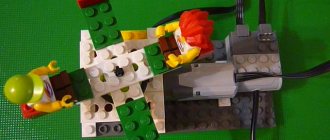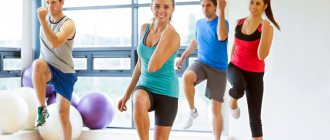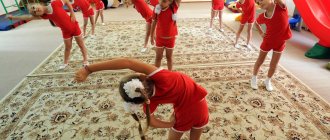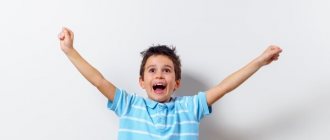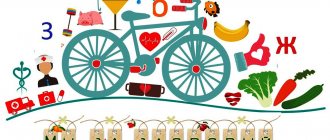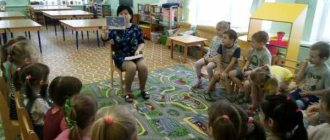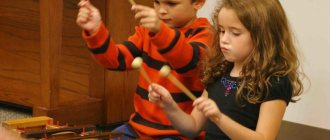Group exercise corner
Authors:
Myakisheva Lyubov Vladimirovna – teacher of the highest category
Tsvetkova Anastasia Andreevna - teacher
MADOOU CRR - kindergarten No. 177 in the city of Tyumen
“Children are exactly the same as adults
I want to be healthy and strong,
Only children don’t know what to do for this.”
Janusz Korczak
The goal of our preschool educational institution is to create favorable conditions for the formation of a successful personality of a preschooler, the preservation and strengthening of health, and the comprehensive development of physical qualities.
We promote the development of initiative and independence in children's daily physical activity. Motor activity is the basis of a child’s individual development and life support. Movement is a means of understanding the world around us, satisfying biological needs on which children’s health, their physical and general development depend.
In accordance with the Federal State Educational Standard, a preschool educational institution graduate must have good health, good physical development, and physical fitness.
In order for children to move actively, adults must create favorable conditions. The motor environment should be saturated with various equipment and sports equipment. Our group has a physical training room. Our physical education corner has a wide variety of sports equipment: health tracks, tags, dominoes, checkers, ring throws, hummocks, golf, skittles, gymnastic sticks, balls and much more.
The physical education corner should be maximally adapted to meet the children’s need for movement. The following requirements are imposed on the physical education corner and its equipment: pedagogical, aesthetic, hygienic. With the help of the physical education corner, the independent motor activity of children develops well.
Children enjoy using sports equipment in their daily life at the kindergarten.
The kids love to take part in various relay races, for example, using ring throw. Children develop interest in sports, development of accuracy, dexterity of movement, and orientation in space.
Children also enjoy relay races involving climbing and jumping over obstacles.
For this we use gymnastic sticks and cones . Physical qualities such as flexibility, endurance, intelligence, speed and clarity of movement develop. Children become more interested in the game, their mood rises, and they feel like one with the team.
Physical education equipment “bumps” can also be used in relay races, when running with obstacles, taking a ball in your hands and passing it to each other.
Also, to improve movements, develop speed, endurance, and coordination of movements, children love outdoor games. In the formation of a child’s diversified personality, outdoor games are given the most important place. They are considered as the main means and method of physical education. Being an important means of physical education, outdoor play simultaneously has a healing effect on the child’s body.
For example, such as “traps”, where they use multi-colored ribbons. Children play in a team, navigate the current situation, develop qualities such as will, desire to win, strength, dexterity and speed of reaction.
Active physical activity, in addition to its positive impact on health and physical development, provides psycho-emotional comfort for the child. For example: rolling a ball to each other during the verbal-logical game “I know 5 names...”.
A large number of movements activates breathing, blood circulation and metabolic processes. This in turn has a beneficial effect on mental activity. Articulation gymnastics is carried out using non-traditional sports equipment.
The game of golf cannot be played without a club and a ball. With the help of this game, children develop their eye and accuracy of movement.
Tag is a game that develops children's thinking, concentration, intellectual abilities, ability to work in a team, joint decision-making, and develops counting.
Checkers develop logical thinking.
Dominoes teach children the ability to play together and obey the rules of the game.
To prevent flat feet and provide various effects on children’s feet, health tracks are used. Regular massage of the feet helps to improve the child’s health daily and easily.
The health track allows you to make this process not only useful, but also very exciting. For example, using bags for balance and coordination of movement.
Thus, the creation of a developmental environment for independent motor activity of children, adequate to their age and needs, helps to improve health, expand motor experience, develop a strong interest in physical exercise, self-organization skills and communication with peers.
We invite teachers of preschool education in the Tyumen region, Yamal-Nenets Autonomous Okrug and Khanty-Mansi Autonomous Okrug-Yugra to publish their teaching materials: - Pedagogical experience, original programs, teaching aids, presentations for classes, electronic games; — Personally developed notes and scenarios of educational activities, projects, master classes (including videos), forms of work with families and teachers.
Why is it profitable to publish with us?
1. “Kindergartens of the Tyumen Region” is an officially registered specialized media outlet at the federal level. 2. The activities of the editorial office are supported by the Department of Education and Science of the Tyumen Region 3. We issue a “Certificate of Publication” in the media. 4. The document has a unique number, is entered in the register, has the original seal of the editorial office of the online publication and signature. 5. “Certificate of publication” in the media is sent to the author in both paper and electronic versions.
Details >>>
Sample “Certificate of publication of author’s methodological material in the media.”pdf
Share
The purpose and objectives of the sports ground in kindergarten
The main goal of the physical zone is to introduce preschool children to a healthy lifestyle and stop their craving for movement. This need is natural for kindergarteners, so the task of the mentor is to promote their physical education. Teach children how to properly use gym equipment in kindergarten and how to move safely in a limited area.
Objectives of the sports zone in kindergarten
The main task of a gym in a kindergarten is to organize optimal conditions for active pastime and acquiring the physical fitness desired for a particular age. The corner’s tasks also include:
- introducing children to sports;
- prevention of dysfunctions of the musculoskeletal system;
- polishing motor functions.
Below is a table that outlines the tasks of the sports zone based on the age of the children.
| Age group | Tasks |
| Junior (up to 4 years old) |
|
| Medium (4 to 5 years) |
|
| Senior (from 5 years old) |
|
| Preschool (from 6 to 7 years old) |
|
The design of the physical education area should directly resonate with its objectives for each age group. And the complete physical development of children depends on its equipping with sports equipment for kindergarten.
Preview:
Group exercise corner
“Children are exactly the same as adults
I want to be healthy and strong,
Only children don’t know what to do for this.”
Based on the requirements of the Federal State Educational Standard, a distinctive feature in the configuration of a physical education corner should be:
- content richness, necessary and sufficient materials for all types of children's activities;
- flexibility of the playing space, multifunctionality of the environment and playing materials (presence of substitute items);
- variability in the availability of materials and equipment for children’s free choice;
- periodic change of game material, availability of game materials, the ability to use all elements of the environment.
The purpose of the physical education corner: ensuring and regulating the level of physical activity of children in the daily routine.
Objectives of the physical education corner:
- acquisition of motor experience and physical qualities: coordination and flexibility;
- proper formation of the body’s musculoskeletal system;
- development of balance, coordination of movement, gross and fine motor skills of both hands;
- consolidation of the skill of performing basic movements (walking, running, soft jumps, turns in both directions);
- formation of initial ideas about some sports;
- mastering outdoor games with rules;
- formation of focus and self-regulation in the motor sphere;
- formation of healthy lifestyle values, mastery of its elementary norms and rules (in nutrition, physical activity, hardening, in the formation of useful habits, etc.)
- Create a varied physical education and gaming environment aimed at optimizing motor activity.
- Enrich children with basic knowledge about the variety of outdoor games and physical exercises.
- Develop motor qualities and abilities (speed, agility, coordination, flexibility, expressiveness of movements.
- Encourage children's motor creativity.
- Form the foundations of a healthy lifestyle in the family and kindergarten.
Requirements for a sports corner:
- Safety of placement: the sports corner should not be placed near windows, the science and nature center, the sand and water center, the theater and music center. It can be placed: in a reception room, group room or bedroom.
- Meet hygienic and pedagogical requirements, and location - the principle of expediency.
- The corner should logically fit into the interior of the room and be aesthetically designed.
- The corner must correspond to the age of the children and the requirements of the program, and provide free choice and access for children.
- The materials from which the equipment is made must meet hygienic requirements, be environmentally friendly and durable.
The need for physical activity is natural for preschoolers. The younger the child, the less self-regulation he has. Therefore, frequent changes of activity include a physical education component. As part of the social order for the preparation of a comprehensively developed personality, the physical education program is aimed at improving the child’s motor activity and creating sustainable motivation for a healthy lifestyle.
The subject-spatial environment of the group consists of children's activity centers and includes a physical education corner, mandatory for all age groups. The role of this corner is to enrich the set of outdoor games: the teacher explains the rules, children learn the game and remember it in independent activities (in kindergarten, on a walk, at home). The saturation of the physical education corner with objects for games and exercise equipment develops motor skills and coordination of movements in children, and helps strengthen muscles. Regular exercise increases the body's endurance and increases resistance to seasonal diseases.
Passport of the sports corner
The corner passport is a mandatory document; it is stored in the teacher’s general documentation folder or in a special box directly in the children’s activity center. The passport can be drawn up in free form, describing in it the goals and objectives that were set by the teacher for registration and work, location, equipment. You can add a corner sketch and photographs as an attachment.
Template for drawing up a physical activity corner passport:
- name of the corner;
- group number, age of children;
- goals and objectives of the corner;
- pieces of furniture, their quantity;
- attributes for outdoor games and exercises, their quantity;
- didactic materials (wall posters, thematic albums and magazines, achievement boards, printed boards and didactic games on sports);
- a card index of games and exercises in the sports corner (voluminous material, it can be filed in a separate folder and stored in the didactic materials of the corner).
Corner design tools
The design of the physical activity corner depends on the imagination of the teacher. Children will be interested in visiting the development center not only for the purpose of conducting outdoor games, but to study visual materials, thematic exhibitions and didactic materials. It is recommended to involve the pupils themselves and their parents in the creation of objects for the aesthetic design of the corner: give tasks for productive creativity on the topic “Sports”, think together about the content of the information stand, ask them to draw posters and wall newspapers together with their parents. Attributes of a physical education corner
Attributes for active and sedentary games, emblems, masks, equipment (for example, ribbons for all age groups). To prevent flat feet and develop fine motor skills of the hands: bags of cereals (beans, peas, beans, etc.) in different shapes for walking; mats and massage paths with reliefs, “ribs”, rubber spikes, etc.; waste material (cones, eggs from Kinder surprises, etc.) for grabbing and moving from place to place with your feet and toes; non-standard equipment made by yourself; hedgehog balls; bags with different cereals for hands; expander (middle and older ages). For games and exercises with jumping: jump ropes, hoops, cords, bars. For stepping, ascent and descent: wooden blocks, plastic steps, modules. For games and exercises with throwing, catching, throwing: ring throw, rubber balls of different sizes, bouncy balls (middle and senior groups), balls or sandbags for throwing (middle and senior groups), baskets for throwing games, a throwing target or darts with Velcro balls (middle and older ages), skittles, non-standard equipment. Outdoor materials (according to the age of the children: rubber balls, soccer ball (middle and older age), badminton (senior age), jump ropes, ski hoops, hockey sticks, sleds, etc. With the help of the physical education corner, the independent motor activity of children is excellently developed. Children enjoy using sports equipment in the daily life of the kindergarten. Children love to participate in various relay races, for example, using ring throw. Children develop a sports interest, develop accuracy, dexterity of movement, and spatial orientation.
Requirements for the design of a sports corner in a kindergarten
When developing the layout of a sports ground, you need to remember that children of preschool age will be playing on it. Therefore, the corner for sports equipment must comply with the following rules:
- Safety The sports corner should be located in a safe place, away from fragile, sharp or heavy objects. Sports equipment should also be environmentally friendly and safe.
- Optimal placement It is better to divide the gym into zones according to the physical elements. This will help save a lot of space. And sports equipment should be placed so that it does not interfere with the motor activity of children. The corner in the group should be located next to the play area and the place of theatrical activities.
- Ease of use All equipment for exercises and games should be freely accessible, based on the age of the children, their gender and interests.
- Aesthetic design The physical development center in the garden should be aesthetically designed. It would be better if it was bright sports equipment. This design will attract attention and encourage action. It would be ideal to design the physical education area in the same style as other development sectors of the group.
- Testing All equipment must be subject to a load test and visual inspection.
Important! When developing a project for a sports complex for a kindergarten, you need to pay attention to its size. According to standards, each child must have at least one square meter of space.
Even more information about the requirements and design features of a sports zone in the following video:
